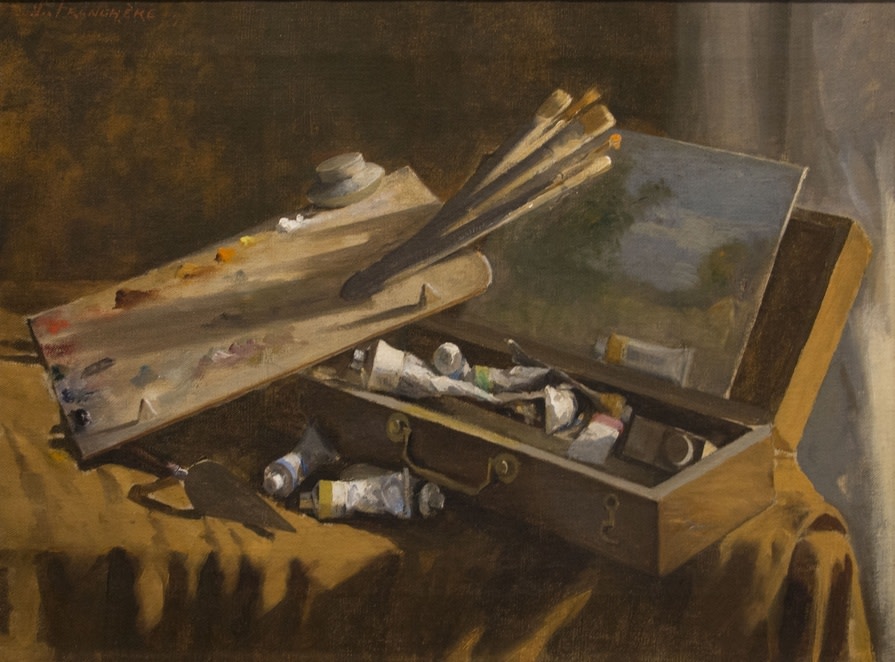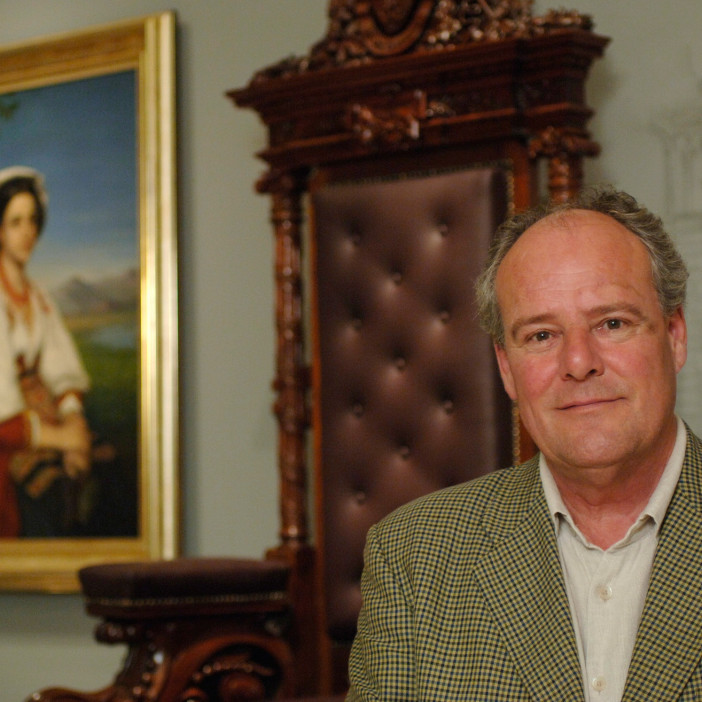Painter’s Tools by Joseph-Charles Franchère: A Glimpse Into the Artists’ Process

Painter’s Tools by Joseph-Charles Franchère is signed and dated 1894, a year of transition for the then 28-year-old artist. Franchère had returned to his native Montreal and was embarking upon his professional career after several years spent studying in Paris since 1888. During a brief visit to Montreal in 1890, he received an important commission to paint three large religious canvases for the Notre-Dame-du-Sacré-Cœur chapel of the Notre-Dame basilica (unfortunately destroyed in a fire in 1978) and which incited him to return to France to perfect his talent. While in Paris, he studied at the École des beaux-arts under Jean-Léon Gérôme, as well as at the Julian and Colarossi Academies under Benjamin-Constant, Jules Lefebvre and Joseph Blanc.
During this period, Franchère also exhibited a Still Life (of unknown subject) in Canada, first in 1891 at the Art Association of Montreal, then in 1893 at the Royal Canadian Academy of Arts. The numerous and varied paintings (portraits, landscapes, genre subjects) he made while studying and training abroad often bear the mention “Paris” beneath his signature. With no such mention on Painter’s Tools, we may safely infer that it was painted in Montréal, since the Lovell directory for 1893-1894 registers the artist’s atelier on Saint Lawrence Boulevard, at the Monument national, and his residence on Notre-Dame.[1]
The painting depicts a close-up of Franchère’s tools, scattered on a table covered with a tablecloth and illuminated by the bright light streaming through a window draped by a curtain on the right. We can see a spatula, a portable folding palette mottled with dabs of colour, brushes and an open paintbox containing various tubes of paint; a pochade of a landscape on board is resting against the top of the painbox. Patented in 1841 though not commercialised in France until 1859, pre-prepared tubes of paint, supple and sealed hermetically with a cap, organised and carried in a case, made it possible for artists to paint outside - revolutionising the painting process and enabling, as some historians portend, the birth of impressionism.
In spite of the haphazard appearance, Franchère’s careful placement of the objects creates a composition with two crossing diagonals. Painter’s Tools is painted with large brush strokes in tones of ochre, lightly applied as if in watercolour. Only the colours of the tubes and on the palette as well as the sky of the pochade bring touches of radiance and highlight to the composition. The warm lighting creates strong contrasts between the brightly lit objects and the long shadows they cast. A unique subject in Canadian art history, Franchère’s still life portraying the attributes of his profession can be linked to his superb self-portrait, also dated 1894, which hangs in the Musée national des beaux-arts du Québec. It represents the artist in his smock and necktie, standing at his easel, pipe in his mouth, holding his brushes and palette, though a different palette than the one in Painter’s Tools. As with a self-portrait, the still life offers a mirrored image since it depicts the very equipment which is required to represent it.
Painting from life and by extension through direct observation, Franchère goes beyond his classical, academic French training with this still life towards a certain modernity, as much through the subject matter of Painter’s Tools as through his treatment of the study.
By Mario Béland, PH. D., FRSC
Footnotes:
- On Franchère, see Albert LABERGE, Peintres et écrivains d’hier et d’aujourd’hui, Montréal, private edition, 1938, p. 185-195 ; Alfred LALIBERTÉ, Les artistes de mon temps, text presented and annotated by Odette Legendre, Montréal, Le Boréal, 1986, p. 110-112 ; David KAREL, Dictionnaire des artistes de langue française en Amérique du Nord, Québec, Musée du Québec et Les Presses de l’Université Laval, p. 312 ; Laurier LACROIX, sous la dir., Peindre à Montréal, 1915-1930. Les peintres de la Montée Saint-Michel et leurs contemporains, Montréal, Galerie de l’UQAM, Québec, Musée du Québec, 1996, p. 129-130 ; A. K. PRAKASH, L’art canadien. Maîtres choisis de collections privées, Ottawa, Éditions Vincent Fortier, 2003, p. 64-69 ; Anne-Élisabeth VALLÉE, «Joseph-Charles Franchère », Passion privée. L’art moderne du Québec de la collection Pierre Lassonde, Québec, Musée national des beaux-arts du Québec, 2015, p. 37-41.
- La phrénologie, a symbolic allegory painted by Ozias Leduc two years earlier, also shows various instruments for drawing and painting (Lavalin Collection at the Musée d’art contemporain de Montréal). Painters rarely represent themselves in their self-portraits with their tools such as a palette. Some examples worthy of mention are Théophile Hamel, ca. 1849 (Musée national des beaux-arts du Québec (MNBAQ)), William Sawyer, in 1861 and in 1884 (Private collections, Kingston), William Hind, during the 1870’s (Library and Archives of Canada, Ottawa and McCord Museum, Montréal), Zacharie Vincent, ca. 1875 (MNBAQ), Antoine Plamondon, in 1882 (Musée de la civilisation, Québec), Ernst Neumann, in 1930 (National Gallery of Canada, Ottawa), Frederick B. Taylor, in 1941 (Library and Archives of Canada), etc. See Robert STACEY, The Hand Holding the Brush : Self Portraits by Canadian Artists / La main qui tient le pinceau : autoportraits d'artistes canadiens (Exhibition catalogue), London, Ontario, London Regional Art Gallery, 1983, 130 p. Also pertinent is the self-portrait of Robert Harris sketched in 1892, on a paint box (Confederation Centre Art Gallery and Museum, Charlottetown) or the astonishing Vue de l'atelier à l'Autoportrait d’Eugène Hamel, painted in Italy in 1869, showing a palette hanging on an easel (MNBAQ). See Mario BÉLAND, « Un autoportrait unique dans l’art québécois », Cap-aux-Diamants, no 77 (printemps 2004), p. 63. Also worth noting is the superb palette painted by Paul Peel, ca 1890, at the National Gallery of Canada, Ottawa.







